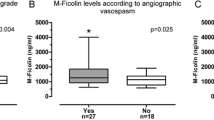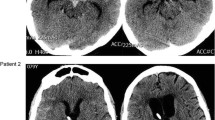Summary
Fibrinopeptide A (FPA) levels as an indicator of thrombin activity in the cerebrospinal fluid (CSF) and plasma of 25 patients with subarachnoid haemorrhage (SAH) were measured serially by radioimmunoassay (RIA). FPA levels in CSF were extremely high on days 0–1 (1253±269 ng/ml, mean ± standard error) but decreased rapidly (11.3±3.9 ng/ml on days 2–4, 10.7±5.9 ng/ml on days 5–7, and 6.3±1.5 ng/ml on days 8–14). In the controls the FPA concentration in CSF was 1.2±0.9 ng/ml (mean ± standard deviation). Plasma FPA levels in patients with SAH showed no statistically significant changes with time.
The bradykinin (BK) concentration in CSF and plasma in 27 patients with SAH was measured serially by RIA. The cocentrations in CSF were 122.7±22.7 pg/ml (mean ± standard error) on day 0, 38.6±6.1 pg/ml on day 1,22.7±6.3 pg/ml on day 2, and 17.1±3.0 pg/ml or less thereafter. Plasma BK levels in patients with SAH were higher than those in the control group, but there was no statistically significant change over time.
From the measurement of FPA it was apparent that the coagulation system in the subarachnoid space is strongly activated in the early stage of SAH. The formation of BK in CSF after SAH is thought to be due to the contact activation of Hageman factor (intrinsic factor) in the subarachnoid space. Trabeculae as collagen bundles in the subarachnoid space were considered to have a possible role in activating the Hageman factor of the coagulation system in SAH.
Similar content being viewed by others
References
Abe K, Sakurai Y (1980) Plasma kinin. Clin All-round 29: 2566–2570 (in Japanese)
Anderson M, Matthews KM, Stuart J (1978) Coagulation and fibrinolytic activity of cerebrospinal fluid. J Clin Path 31: 488–492
Asai T (1977) The effect of the intraventricular blood component on both the production and absorption rate of cerebrospinal fluid in dog. (Part II) Neurol Med Chir (Tokyo) 17: 493–498 (in Japanese)
Elliotto DF, Lews GP, Horton EW (1960) The structure of bradykinin — a plasma kinin from ox blood. Biochem Biophys Res Commun 3: 87–91
Fisher CM, Kistler JP, Davis JM (1980) Relation of cerebral vasospasm to subarachnoid hemorrhage visualized by computerized tomographic scanning. Neurosurg 6: 1–9
Harpel PC (1972) Studies on the interaction between collagen and a plasma kallikrein-like activity. J Clin Invest 51: 1813–1822
Hoshi T, Shimizu T, Kito K, Yamasaki N, Takahashi K, Takahashi M, Okada T, Kasuya H, Kitamura K (1984) Immunological study of late cerebral vasospasm in subarachnoid hemorrhage. Detection of immunoglobulins, C3, and fibrinogen in cerebral arterial walls by immunofluorescence method Neurol Med Chir (Tokyo) 24: 647–654 (in Japanese)
Hunt WE, Kosnik EJ (1974) Timing and perioperative care in intracranial aneurysm surgery. Clin Neurosurg 21: 79–89
Kariya K, Kawauchi R, Okamoto H (1981) Regional distribution of kininase in rat brain. J Neurochem 36: 2086–2088
Kariya K, Yamauchi A, Hattori S, Tsuda Y, Okada Y (1982) The disappearance rate of intraventricular bradykinin in the brain of the conscious rat. Biochem Biophys Res Commun 107: 1461–1466
Kizuki K, Moriya H (1986) Biochemical aspects of the kallikreinkinin system — progress and recent topics. J J Inf 6: 221–232 (in Japanese)
Lopes CAS, Mair WGP (1974) Ultrastructure of arachnoid membrane in man. Acta Neuropath (Berlin) 28: 167–173
Maier-Hauff K, Beathmann AJ, Lange M, Schurer L, Unterberg A (1984) The kallinkrein-kinin system as mediator in vasogenic brain edema. J Neurosurg 61: 97–106
Mcgiff JC (1980) Interaction of prostaglandins with the kallikrein-kinin and renin-angiotensin systems. Clin Sci 59: 105s-116s
Nakahara M (1980) Binding and dissociation of Hageman factor, prekallikrein and high molecular weight kininogen in human plasma during contact activation. Biochem Pharmacol 29: 1247–1254
Nasjletti A, Malik KU (1979) Relationship between the kallikrein-kinin and prostaglandin systems. Life Sci 25: 99–110
Nossel HL, Ti M, Kaplan KL, Spanondis K, Soland T, Butier VP (1976) The generation of fibrinopeptide A in clinical blood samples, evidence for thrombin activity. J Clin Invest 58: 1136–1144
Nossel HL, Jensen AH, Liu CY, Koehn JA, Canfield RE (1983) Molecular biology of fibrinogen and fibrin: Fibrinopeptide release from fibrinogen. Ann N Y Acad Sci 408: 269–278
Okada T, Shimizu T, Yamasaki N, Takahashi K, Hoshi T, Kasuya H, Kitamura K (1985) A study on coagulation and fibrinolysis of subarachnoid hemorrhage — by measurement of fibrinopeptide A and fibrinopeptide B beta 15–42 in blood and in cerebrospinal fluid. Igaku No Ayumi 134: 581–582 (in Japanese)
Regoli D, Berabe J (1980) Pharmacology of bradykinin and related kinins. Pharmacol Rev 32: 1–46
Rocha e Silva M, Beraldo WT, Rosenfeld G (1949) Bradykinin, a hypotensive and smooth muscle stimulating factor released from plasma globulin by snake venoms and by trypsin. Am J Physiol 156: 261–273
Ryan JW, Roblero J, Stewart JM (1968) Inactivation of bradykinin in the pulmonary circulation. Biochem J 110: 795–797
Shimizu T, Kito K, Yamazaki N, Takahashi K, Takahashi M, Yamane K, Sim C, Kitamura K, Sendo S (1982) Immunological study of late cerebral vasospasm in subarachnoid hemorrhage. Neuro Med Chir (Tokyo) 22: 613–619 (in Japanese)
Sicteri F (1968) Treatment of subarachnoid and other intracranial hemorrhages with proteinase inhibitors. Ann N Y Acad Sci 146: 682–700
Sicteri F, Fanciullacci M, Bavazzano A, Franchi G, Del Bianco PL (1970) Kinins and intracranial hemorrhages. Angiology 21: 193–210
Takanashi N, Ohno Y, Aoyama M, Maruyama I, Okada A, Shinmyozu K, Igata A (1983) Plasma kinins measurement by sensitive kinin radioimmunoassay and its clinical application. Thrombosis and Haemostasis 50: 230
Toda N (1977) Action of bradykinin on isolated cerebral and peripheral arteries. Am J Physiol 232: H267-H274
Tovi D, Nilsson IM, Thulin CA (1973) Fibrinolytic activity of the cerebrospinal fluid after subarachnoid hemorrhage. Acta Neurol Scand 49: 1–9
Unterberg A, Dautermann C, Beathmann A, Muller-Esteri W (1986) The kallinkrein-kinin system as mediator in vasogenic brain edema, Part 3: Inhibition of the kallikrein-kinin system in traumatic brain swelling. J Neurosurg 64: 269–276
Vermeulen M, van Vliet HHDM, Lindsay KW, Hijdra A, Gijn JV (1985) Source of fibrin/fibrinogen degradation products in the CSF after subarachnoid hemorrhage. J Neurosurg 63: 573–577
Author information
Authors and Affiliations
Rights and permissions
About this article
Cite this article
Kasuya, H., Shimizu, T., Okada, T. et al. Activation of the coagulation system in the subarachnoid space after subarachnoid haemorrhage: Serial measurement of fibrinopeptide A and bradykinin of cerebrospinal fluid and plasma in patients with subarachnoid haemorrhage. Acta neurochir 91, 120–125 (1988). https://doi.org/10.1007/BF01424566
Issue Date:
DOI: https://doi.org/10.1007/BF01424566




